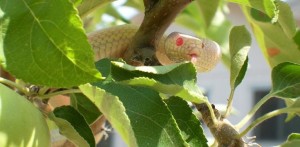A snake charmer, who used to rear snakes at his house at Dhupail Shob village in Lalpur upazila, died from snake bite on Wednesday. Locals said Abdur Rahim, 26, known as Sarparaj, and son of Sentu Mia, reared snakes in his house in the last three years. Earlier, his snakes bit him several times, but he did not fall ill. But on the fateful day, he fell seriously sick when a poisonous cobra bit him at 8am. He was admitted to a local clinic and later shifted to Rajshahi Medical College and Hospital (RMCH), but he died near the hospital gate at 2pm on the day.
Ball python’s days of freedom end in London, Ont.
LONDON, Ont.
— A ball python spotted last month slithering through a residential neighbourhood in London, Ont., managed to elude authorities for weeks, but police said the reptile has finally been captured.
The sneaky snake, which measures 1 1/2 metres long, was discovered Thursday night in a backyard on Avalon Street, curled up inside a tire.
“This one certainly was not a danger to the public, although when people do adopt these animals and they do get large, they need to keep that into consideration,” said Kent Lattanzio, the director of operations for the London Animal Care Centre.
A police officer who first spotted the snake on July 24 after responding to a complaint thought it might be a python.
But animal control officers said they had received a call about a missing red-tailed boa constrictor.
After finally seeing the snake, Lattanzio said it appeared to be a ball python.
A ball python is a non-venomous species. The snake gets its name because of its tendency to curl into a ball.
Lattanzio said the tip about the boa was either false or a mistake.
“Even if this was his snake, maybe he didn’t know the breed properly. There’s all kinds of scenarios,” said Lattanzio, as he tried to explain the confusion behind properly identifying the snake.
London police said the python caught was likely the one which has been on the lam for weeks.
“We believe this was the actual snake we were looking for in July,” said Const. Dennis Rivest.
In London, bylaws prevent people from owning snakes larger than 60 centimetres.
Rivest said on Friday that an officer is trying to track down the person who made the report of a missing boa constrictor.
UPDATE: Snake bites man

Harrisburg Hospital officials say Barry Painter, Sr. has improved, and is now listed in stable condition.
Police say Painter was drunk while playing with a Gaboon viper snake when it bit him Wednesday night.
A friend started driving Painter to the hospital, but he lost consciousness and had to be flown the Harrisburg Hospital.
Harrisburg Hospital is the only hospital in this part of the state with a toxicology center, which means they have anti-venom on stand-by there for bites from snakes native to Pennsylvania. But for exotic,venomous snakes, they have to have the anti-venom flown in from a zoo. In this case, the viper anti-venom was flown in from a zoo south of Williamsport.
Jesse Rothacker with the Forgotten Friend Reptile Sanctuary has some tips, if you own a venomous snake.
” If you’re going to own a venomous snake, never handle it under the influence, don’t use your bare hands, use hooks, or special tools,” said Jesse Rothacker, Forgotten Friend Reptile Sanctuary.
Jesse says the best advice is, if you’re thinking about getting a pet that’s a reptile, stay away from venomous things, get a lizard or a turtle.
This isn’t a snake you stumble upon in the woods when you go camping. Snake experts say it’s non-native to PA and therefore, not regulated by the state. The Gaboon Viper Snake is an African snake and has the longest fangs of any snake in the world. Its venomous bite can kill a full grown human within 15 minutes or quicker.
Boa constrictor ‘thrown into Gloucestershire canal’

The incident, at Bowbridge near Stroud on Thursday evening, was reported to police by a member of the public.
The man is described as white, 45 to 50 years old and balding with a moustache and he was wearing black jeans, a black shirt and boots.
He left the area in a grey Ford Fiesta, driven by a woman.
‘Long-term commitment’
Rural and environmental crime officer, Pc Jon Palfrey, said: “We understand that in the current financial climate, people may be struggling to take care of their much-loved pets.
“But we assure you there are solutions to the problem that mean you don’t have to go to such an extreme.”
A spokesperson for the RSCPA said releasing a non-native animal into the wild was against the law.
“Before taking on any animal, it is extremely important that you thoroughly research the needs and requirements of the species,” he said.
“Snakes are a significant and long-term commitment. Boa constrictors can live for 40 years in captivity and can grow to four metres (13ft) in length.”
Police urged the man to come forward and appealed for further witnesses.
Wildlife experts said the snake could still be alive if it had been able to find warmth, but it was unlikely to survive the winter.
Reptile Breeders’ Expo
National Reptile Breeders’ Expo 2010, which bills itself as the largest repitle meeting in the world, will be in Daytona Beach at the Ocean Center and Daytona Hilton on Friday through Sunday, Aug. 20-22.
The expo includes symposiums on chameleons, turtles and tortoises and morelia genus snakes such as the scrub and carpet pythons. Speakers from around the world will lead the symposiums, and a Cold Blood Creations art show will be open on Saturday and Sunday. For information, go to the expo website by clicking here.
Researchers put a new twist in tale of an ancient lizard
Two Canadian scientists have helped give one of the most ferocious monsters of the dinosaur age a major makeover.
Overturning decades of conventional wisdom about the shape and swimming style of the mosasaur — a huge marine lizard known from fossil discoveries in Alberta, Saskatchewan and Manitoba — the researchers’ new study has pinned a shark-like tail on the predatory reptile that ruled the vast oceans of Cretaceous Canada.
University of Alberta scientists Michael Caldwell and Takuya Konishi, along with colleagues in Sweden and the U.S., published their findings this week in PLoS One, a journal of the U.S.-based Public Library of Science.
The researchers based their conclusions on a fresh study of the finest preserved mosasaur in existence, a sub-species known as platecarpus held by the Natural History Museum of Los Angeles County.
Their analysis of the seven-metre-long creature’s body size and bone structure led them to debunk a long-standing theory that mosasaurs had a tapered tail and moved with eel-like undulations in search of fish and other prey some 85 million years ago.
Instead, they concluded, the shape and orientation of the lizard’s back bones must have supported a crescent-shaped tail fin — unlikely to be preserved in fossil form — that gave it a powerful swimming thrust similar to that of a great white shark.
Like other groups of sea creatures that evolved to maximize their swimming speed and efficiency, the researchers state in the journal article, mosasaurs radically modified their tails, stiffened their backbones, and reduced their rear limbs to meet the demands of marine life.
If the new theory holds, showcase mosasaur reconstructions at dinosaur museums around the world — including several in Canada — may require some remodelling to add a prominent tail to the extinct beast.
“This fossil shows evolution in action, how a successful design was developed time after time by different groups of organisms adapting to life in similar environments,” co-author Luis Chiappe, director of the Los Angeles museum’s Dinosaur Institute, said in a summary of the study. “It highlights once again the potential for new discoveries to challenge well-established interpretations about dinosaurs and other animals that lived with them.”
The first fossilized mosasaur remains were discovered in 1770 in a cave in the Netherlands. Along with the numerous specimens collected from Western Canada, mosasaurs have been found in many sites around the world — a testament to the widespread success of the species for millions of years during the Cretaceous era.
Notable Canadian specimens include the famous Manitoba mosasaur nicknamed Bruce, a 13-metre-long individual dug up near the town of Thornhill in 1974 and now displayed at the Canadian Fossil Discovery Centre in Morden, Man.
Albino gator in SC Aquarium finally has a name
CHARLESTON, S.C. —
Visitors to the South Carolina Aquarium may now address the albino alligator that’s on display as Alabaster.
The name collected 570 votes during voting held during the past month by the aquarium in Charleston. The name “Lightning” came in second place, followed by “D’wight Gator” and “Big Al.”
Experts say the light-sensitive alligator is believed to be one just one of only 50 living in the world.
The gator has a home with snakes, owls and fish in the black water swamp exhibit at the aquarium on the Cooper River waterfront in Charleston.



